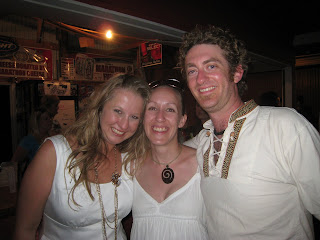I wasn't the biggest fan of Michael Jackson's music, especially after I turned a certain age and was less affected by pop-music, at least pop-music that wasn't pop-hard-rock or pop-metal. When you're three or four years old when Thriller comes out, chances are you'll have seen the videos (if you had MTV) and known the beats of "Beat It" and "Billie Jean" by either having parents who played the record or by a form cultural osmosis.
By the time I was head-banging to ...And Justice For All, any affinity I had for MJ was long gone. And by then, he was becoming weirder and weirder. Then he had the kids over for a "slumber" party, and the Wacko Jacko moniker seemed to suit him best.
So I wasn't the biggest fan, which really meant I had no idea what a Michael Jackson was, or how he came to revere himself the way he did, or how the fans came to revere him the way they did. Since his death, there have been some essays printed in the papers here that helped me come to understand what had been going on ten years before I was born.
A prodigy cutting his first hit single, with his prodigy brothers, at the age of six? Coming out of the Rust Belt? By 1969, Michael Jackson was 11, and the Jackson 5 had a series of hits, "I want you back", "I'll be there", "ABC", that were selling like crazy, and doing so mostly on the power of the young Michael's amazing ability to sing with passion and authority on topics like love and loss that no 11 year-old should or could have any business discussing.
According to these essays, it seemed like the Jackson 5 were breaking down age barriers as well as racial barriers. It was 1969-70 after all, a time of anti-war protests, hippies, afterglow from winning some semblance of Civil Rights, Vietnam and Woodstock...
The kid had talent, for sure, but is there any way for this young man, really, this child, to develop in a natural and normal way like a regular person? I watched an interview between MJ and an older black man, an editor with Jet/Ebony Magazine, that was conducted on the set of the "Beat It" video in something like '82-'84. This was before interviews tended to go towards questions about his bizarre personal life, before he, Michael Jackson himself, leaked false stories to the press about the hyperbaric chamber bed and buying the Elephant Man's bones (his idea of practical jokes, which in reality damaged his image worse than he would have guessed), and the older black man had a nice mix of star-struck awe and affable sincerity. This is Michael Jackson, you could tell his demeanor was saying, he's one of us and he's changed the musical world, but I'm cool and he's cool, so we can talk.
The gentleman asked him how his schooling had gone (private school and tutors, public school for a few days, but the crush of fans was dangerous and unbearable), how his knowledge of "the streets" had developed (from movies), and who his friends now-a-days were (uhh..."I love all my fans..."). Here's a 25 year-old man, with a squeaky voice like a child's, famous the world over, immensely rich and well-liked, without a single friend. Or confidante. Besides Quincy Jones and Diana Ross, who perhaps could have offered a non-celebrity type of friendship, it didn't seem like this young man had ever had a friend.
The skin condition that drained his skin of melanin is almost common here in Brooklyn, but these folks don't have image consultants to use pancake makeup to even out their complexion, making them look whiter than most white people. There are some photos of Michael without the makeup, and you can see the blotchiness. Almost tragically poetic that someone so self-conscious about his image would have a condition that is nearly impossible to hide; the only treatment being almost wholesale painting of your skin to even it out.
Michael's childhood had been pretty much robbed. He's said this himself. That's why he built his Neverland Ranch...I'm guessing not to lure little kids, but to share his ideas of childhood enjoyment with kids. In his first trial for molestation, a shrink testified that he wasn't capable of predatory sexual advances, simply because he wasn't mature enough...at almost 35 years old. Maybe you believe the shrink and maybe you don't.
Having little boys share your bed, as a 30+ year-old, whether there's any sexual activity or not, overnight, is inappropriate and could be considered abusive to the young boys.
In the later trial, with MJ now a 40+ year old, ostensibly having his own children (I'm having a hard time buying the photographs...those babies don't really look Mulatto), and we're hearing about "Jesus Juice" and gay pornography...what the hell's going on?
Michael Jackson is a weird perv, it sounds like, before 2003 this is all known, and from recorded tapes it sounded like the father of the victim/accuser had planned to send his boy to Neverland for financial gain? Setting your child up to make some money? You know Jacko is not all there...maybe I misinterpreted the transcripts...I bloody hope so, anyway.
The autopsy revealed that Michael had only half dissolved pills in his stomach, needle points all over his body, virtually no hair, and weighed only 112 pounds. Some people are okay with his exit; suitable payment for past transgressions.
I suppose you'd have to have been touched by his music to really mourn him. I recognize skill, talent, and showmanship, but I still don't consider myself a "fan" in most senses. And, ultimately, recognizing the tragedy that surrounded his life at all steps is not the same as mourning him.






































